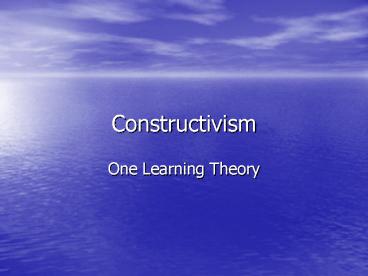Constructivism - PowerPoint PPT Presentation
1 / 28
Title:
Constructivism
Description:
The following are actual responses from students at a Catholic elementary school ... Lot's wife was a pillar of salt by day, but a ... This is called monotony. ... – PowerPoint PPT presentation
Number of Views:146
Avg rating:3.0/5.0
Title: Constructivism
1
Constructivism
- One Learning Theory
2
Warm Up
3
Kids Say the Darnedest Things
- The following are actual responses from students
at a Catholic elementary school on a test about
the Old and New Testaments. They were published
by www.LOLFun.com .
4
Adam and Eve were createdfrom an apple tree.
5
Noahs wife was called Joan of Ark.
6
Lots wife was a pillar of salt by day, but a
ball of fire by night.
7
Samson slayed the Philistines with the axe of the
Apostles.
8
Moses led the Hebrews to the Red Sea, where they
made unleavened bread which is bread without any
ingredients.
9
The first commandment was when Eve told Adam to
eat the apple.
10
The seventh commandment is thou shalt not admit
adultery.
11
The greatest miracle in the Bible is when Joshua
told his son to stand still and he obeyed him.
12
David was a hebrew king skilled at playing the
liar He fought the Finklesteins, a race of
people who lived in Biblical times.
13
Solomon, one of Davids sons, had 300 wives and
700 porcupines.
14
When Mary heard that she was the mother of Jesus,
she sang the Magna Carta.
15
St John the blacksmith dumped water on his head.
16
Jesus enunciated the Golden Rule, which says to
do one to others before they do one to you.
17
The epistles were the wives of the apostles.
18
St Paul cavorted to Christianity. He preached
holy acrimony, which is another name for marriage.
19
Christians have only one spouse. This is called
monotony.
20
Have you ever had similarly hilarious or
nonsensical responses from students?Why do you
think this happens?
21
Principle Learning is an active process.
Students construct meaning based on previous
knowledge and constructs.
- Research Long term memory requires many
connections to the new knowledge. For example, a
mnemonic can help you remember a random list of
numbers. The brain is a self-organizing system,
not a computer with RAM. - Implication Teaching by telling can result in
unintended learning by students. The instructor
must focus on the student in designing the
learning experience. Activities must challenge
incorrect beliefs without being overly
frustrating.
22
Principle The act of constructing meaning
occurs in the mind of the student.
- Research The brain changes with use, the
billions of neurons and dendrites making new
connections or strengthening existing ones. - Implication A good activity asks students to
reflect on their learning.
23
Principle Learning involves language that
influences learning. Learning is a social
activity.
- Research People talk to themselves when
learning. All students, but especially women and
minorities, benefit from cooperative learning in
which the students can exchange ideas about a new
concept. - Implication We should structure the learning to
take advantage of the social nature of learning
e.g., using small group projects or pairing
students.
24
Principle Learning is contextual.
- Research Learning that has no context becomes
what neuroscientists call inert memory this is
memory that cannot be transferred for use in
another problem, discipline, or context.
Flexible memory has context and a structure and
can be transferred.
25
Principle Learning is contextual.
- Implication New concepts should be taught in
the context of a problem. We should start with a
problem or application and proceed to the
generalization later.
26
Principle Learning takes time and concentration.
- Research Two groups of similar ability students
spend the same amount of time learning new
material (a list of meaningless terms), but one
group studies for a short period of time while
the other revisits the material over a period of
several weeks. The retention rate is 2.5 times
as much for the second group.
27
Principle Learning takes time and concentration.
- Implication To assure new learning goes into
long term memory a spiral approach to teaching
should be used. Depth and additional complexity
is added each time the concept is revisited.
28
Principle Motivation is a key aspect of
learning.
- Research Students learn what they are thinking
about when they are encountering new material. - Implication Students need to know how the new
concepts will be used. We have to be careful
that students do not concentrate on peripheral
ideas such as focusing on the unfairness of the
death penalty rather than interpreting a table or
graph.































